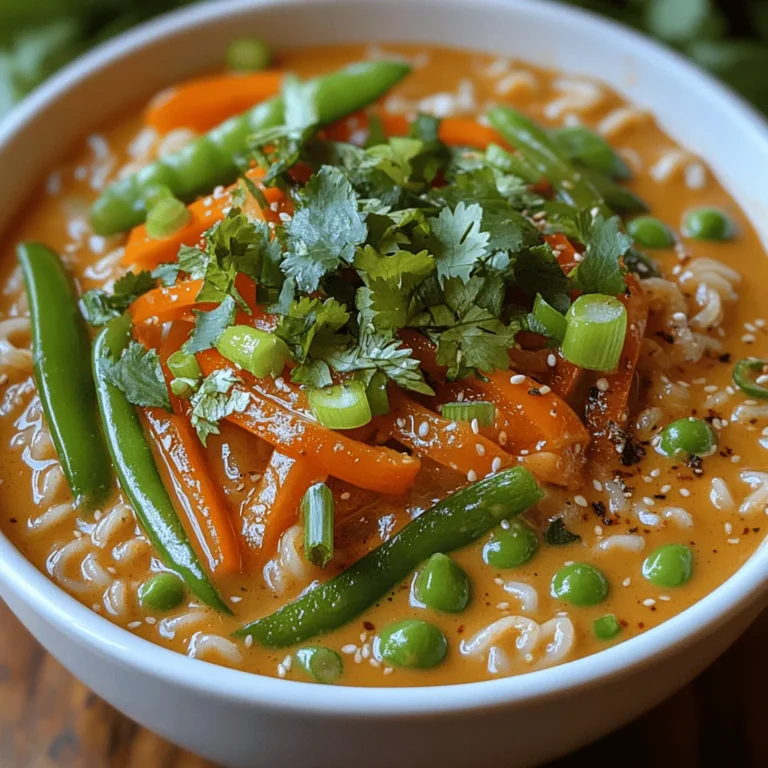Creamy Thai Coconut Noodles: A Culinary Journey
Thai cuisine is renowned for its vibrant flavors, aromatic herbs, and a perfect balance of sweet, sour, salty, and spicy elements. It reflects the rich cultural tapestry of Thailand, where each dish tells a story through its ingredients and preparation methods. One such delightful dish that embodies the essence of Thai cooking is Creamy Thai Coconut Noodles. This dish is not only visually appealing with its vibrant colors but also offers a creamy texture and rich flavors that tantalize the taste buds.
Creamy Thai Coconut Noodles stand out as a versatile recipe, ideal for busy weeknight dinners or meal prep options that can be easily reheated. Whether you are cooking for yourself or entertaining guests, this dish is sure to impress with its exotic flair and comforting qualities. The combination of rice noodles, coconut milk, and fresh vegetables creates a hearty meal that can be enjoyed any time of the year.
Understanding the Ingredients
To master Creamy Thai Coconut Noodles, it’s essential to understand the key ingredients that contribute to its unique flavor and texture. Each component plays a vital role, not only in taste but also in nutrition.
Rice Noodles
At the heart of this dish are rice noodles, which are a staple in many Asian cuisines. Available in various shapes and sizes, such as flat, thin vermicelli, or thicker varieties, rice noodles are gluten-free and an excellent source of carbohydrates. When cooked correctly, they offer a chewy texture that absorbs flavors beautifully. For this recipe, medium-width rice noodles are recommended, as they provide the perfect balance of substance and flexibility, allowing them to soak up the creamy coconut sauce.
Coconut Milk
Coconut milk is the star ingredient that lends Creamy Thai Coconut Noodles its rich and velvety texture. Extracted from the flesh of mature coconuts, coconut milk is not only delicious but also boasts numerous nutritional benefits. It contains healthy fats, particularly medium-chain triglycerides (MCTs), which can provide quick energy and support metabolic health. Additionally, coconut milk is rich in vitamins C, E, and B vitamins, as well as minerals like magnesium and potassium. Its natural sweetness enhances the dish, balancing the heat from the red curry paste.
Red Curry Paste
Red curry paste is another essential component of this recipe, providing depth and complexity to the flavors. This vibrant paste is made from a blend of red chilies, garlic, lemongrass, galangal, and spices, originating from Thai culinary traditions. The heat level can vary based on the brand and the type of chili used, so it’s advisable to start with a small amount and adjust according to your taste preference. Red curry paste not only brings heat but also a beautiful aroma that infuses the dish, making it irresistible.
Fresh Vegetables
Incorporating fresh vegetables into Creamy Thai Coconut Noodles is crucial for enhancing both flavor and nutritional value. Colorful vegetables like bell peppers, carrots, and snap peas not only add a crunch but also contribute vitamins, minerals, and antioxidants. Fresh produce ensures that the dish remains vibrant and nutritious, making each bite not only delicious but also wholesome. Opting for seasonal vegetables can elevate the dish further, allowing you to experiment with different textures and flavors.
Health Benefits of Creamy Thai Coconut Noodles
Creamy Thai Coconut Noodles is not just a treat for the taste buds; it also comes packed with health benefits. The key ingredients contribute to a well-rounded meal that can fit various dietary preferences, including vegan and gluten-free options.
Coconut milk, with its healthy fats, supports heart health and may help with weight management due to its satiating properties. Furthermore, it is dairy-free, making it an excellent alternative for those with lactose intolerance. The inclusion of fresh vegetables adds fiber, which aids in digestion, and a variety of vitamins and antioxidants that support overall health.
Moreover, this dish can be easily tailored to meet specific dietary needs. By using gluten-free rice noodles and a selection of fresh, plant-based vegetables, you can create a nourishing meal that is suitable for nearly everyone.
Step-by-Step Guide to Making Creamy Thai Coconut Noodles
Now that we’ve explored the vibrant background and health benefits of Creamy Thai Coconut Noodles, let’s dive into the cooking process. The following step-by-step guide will walk you through the initial stages of preparing this delectable dish, starting with cooking the noodles.
Cooking the Noodles
1. Choose Your Noodles: Start by selecting the type of rice noodles you prefer. For this recipe, medium-width rice noodles work best, but feel free to experiment with other varieties based on your preference.
2. Boil Water: Fill a large pot with water and bring it to a rolling boil. It’s essential to use plenty of water to prevent the noodles from clumping together.
3. Cook the Noodles: Once the water is boiling, add the rice noodles and stir gently to separate them. Follow the package instructions for cooking time, typically around 4-7 minutes. Keep an eye on them to ensure they do not become overcooked, as they should be al dente.
4. Drain and Rinse: Once cooked, drain the noodles in a colander and rinse them under cold water. This step halts the cooking process and helps prevent sticking. Set aside while you prepare the sauce.
5. Prepare for Mixing: To enhance the flavors, consider tossing the drained noodles with a little oil to keep them from sticking as you prepare the creamy coconut sauce.
With the noodles ready, you’re well on your way to creating a comforting bowl of Creamy Thai Coconut Noodles. Stay tuned for the next section, where we will explore how to bring all these flavors together into a harmonious dish.
{{image_2}}
Tips for Achieving the Perfect Texture
When it comes to creating the ideal texture for your Creamy Thai Coconut Noodles, the key lies in the preparation and cooking methods used. Here are some vital tips to consider:
1. Noodle Selection: Choose noodles that can absorb the sauce well, such as rice noodles or egg noodles. The width of these noodles can also affect the dish; wider noodles tend to hold more sauce, giving you a creamier bite.
2. Cooking Time: Be mindful of the cooking time for your noodles. Overcooking can lead to a mushy texture, while undercooking can result in a chewy, unpleasant experience. Follow the package instructions and taste test a minute or two before the suggested time.
3. Stirring: Gently stirring the noodles during cooking and when combining them with the sauce will help to keep them from clumping together. This technique ensures each noodle is well coated.
4. Cooling: If you’re preparing the noodles in advance, rinse them under cold water after cooking to halt the cooking process. This will maintain their texture and prevent them from becoming gummy.
Preparing the Sauce
The sauce is the heart of the Creamy Thai Coconut Noodles, and preparing it correctly is crucial for achieving the right flavor profile.
1. Sautéing Aromatics: Start by heating a tablespoon of oil in a pan over medium heat. Add minced garlic and ginger, sautéing them for about 1-2 minutes until they become fragrant. This step is essential as it releases the natural oils and flavors from the garlic and ginger, infusing the dish with depth.
2. Combining Ingredients: To the sautéed garlic and ginger, add coconut milk, soy sauce, lime juice, and brown sugar. Stir the mixture gently, allowing the ingredients to meld together. The brown sugar adds a touch of sweetness that balances the saltiness of the soy sauce.
Importance of Sautéing Garlic and Ginger for Flavor
Sautéing garlic and ginger not only enhances the flavor but also adds complexity to the dish. These two ingredients form the foundation of many Thai dishes, providing warmth and a slight spiciness. When sautéed, they caramelize slightly, which deepens their flavors and adds a slight sweetness to the sauce that complements the creamy coconut milk beautifully.
Adding Vegetables
Incorporating vegetables into your Creamy Thai Coconut Noodles not only boosts the nutritional value but also adds vibrant colors and textures.
1. Choosing Vegetables: You can choose from a variety of vegetables based on what’s in season or your personal preference. Bell peppers, snap peas, carrots, and bok choy are excellent options that pair well with the creamy sauce.
2. Cooking Technique: Add the vegetables to the sautéed garlic and ginger, cooking them for about 3-5 minutes until they are just tender but still vibrant in color. This method ensures that the vegetables retain their crunchiness and nutrients.
3. Seasonal Customization: Feel free to customize the vegetable choices based on the season. In spring, asparagus and peas are delightful, while in fall, adding butternut squash can provide a lovely sweetness. This flexibility allows you to enjoy the dish year-round.
Creating the Creamy Sauce
When crafting the sauce, it’s essential to strike a balance of flavors. Here’s how to perfect your creamy sauce:
1. Mixing Ingredients: In a separate bowl, combine coconut milk, soy sauce, lime juice, and brown sugar. Whisk until smooth. The coconut milk creates a creamy base, while soy sauce adds umami, lime juice introduces acidity, and brown sugar lends sweetness.
2. Adjusting Flavors: Taste the sauce and adjust accordingly. If you prefer a tangier flavor, add more lime juice. For a saltier profile, increase the soy sauce. Finding the right balance will make the dish truly pop.
Combining Noodles and Sauce
Once your noodles are cooked and your sauce is ready, it’s time to bring everything together.
1. Draining Noodles: Drain the cooked noodles and add them directly to the pan with the sautéed vegetables.
2. Incorporating Sauce: Pour the creamy sauce over the noodles and vegetables. Using tongs or a spatula, gently toss everything together until the noodles are evenly coated. The key is to ensure every noodle is enveloped in that luscious sauce.
3. Final Touches: If the sauce seems too thick, you can add a splash of vegetable or chicken broth to reach your desired consistency.
Flavor Enhancements and Variations
To elevate your Creamy Thai Coconut Noodles, consider these flavor enhancements and variations:
1. Protein Additions: For added protein, consider incorporating tofu, chicken, or shrimp. Tofu can be pan-fried until crispy, while chicken should be cooked through before adding it to the noodles. Shrimp cooks quickly; simply toss it in during the last few minutes of cooking.
2. Adjusting Spice Levels: If you enjoy a bit of heat, consider adding chili flakes or fresh chilies to the sauce or as a garnish. Start with a small amount and adjust to your taste preference.
3. Creative Twists: For those looking to experiment, you might substitute coconut milk with almond milk or cashew cream for a different flavor profile. This can make the dish lighter while still providing a creamy texture.
Serving Suggestions and Presentation
Presentation can enhance your dining experience. Here are some tips for serving your Creamy Thai Coconut Noodles attractively:
1. Plating Ideas: Serve the noodles in a deep bowl to showcase the vibrant colors of the vegetables and sauce. Twirling the noodles with a fork can create an appealing nest in the center of the bowl.
2. Garnishing Techniques: Top the dish with freshly chopped cilantro, sliced green onions, and a wedge of lime for a pop of color and fresh flavor. A sprinkle of sesame seeds can also add a nutty touch.
3. Pairing Suggestions: Complement your meal with a refreshing cucumber salad or a light Asian slaw. For beverages, consider serving with Thai iced tea or a light lager to balance the meal’s richness.
Conclusion
Creamy Thai Coconut Noodles are not just a meal; they are a delightful experience filled with comforting flavors and vibrant textures. With the right balance of creamy coconut, zesty lime, and savory soy, this dish is sure to impress anyone at your dinner table.
Encouraging creativity in the kitchen, this recipe invites you to explore various vegetables, protein options, and flavor enhancements, allowing you to make it your own. Whether you are hosting friends, sharing a meal with family, or enjoying a quiet night in, these noodles offer an exotic yet comforting escape that will leave everyone craving more.
So, take the plunge and make Creamy Thai Coconut Noodles a staple in your home cooking repertoire. Enjoy the process and the delicious results that are sure to come from your culinary adventures!


